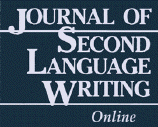|
Volume 14, Number 1 (2005)
Rhetorical education
through writing instruction across cultures: A comparative analysis of
select online instructional materials on argumentative writing (pp.
1-18)
LU LIU
Purdue University, USA
Recent studies on Chinese–English contrastive rhetoric have argued
that there is actually little to contrast and the traditional qi (beginning),
cheng (transition), zhuan (turning), he (synthesis) structure has little
influence on contemporary Chinese writing. A comparative analysis of
select online instructional materials on argumentative writing for American
and Mainland Chinese school writers reveals that although the two groups
agree on the purpose, tripartite structure, and the use of formal logic,
they differ in the discussion of some fundamentals for argumentative
writing. Specifically, the American group considers anticipating the
opposition a must while the Chinese group demonstrates epistemological
and dialogical emphases and highlights the need to use analogies. The
importance of analogies and epistemological and dialogical emphases can
be traced to ancient Chinese rhetorical theories. This paper argues that
the findings may help us to understand the assumptions and beliefs that
underlie rhetorical conventions or textual features. Further comparative
research on Mainland Chinese and American pedagogical materials on argumentative
writing is suggested.
Linguistic correlates of
second language literacy development: Evidence from middle-grade learner
essays (pp. 19-45)
DUDLEY W. REYNOLDS
University of Houston, USA
This paper compares the development of linguistic fluency in the writing
of 5th–8th grade, U.S. students enrolled in English as a Second
Language (ESL, n = 189) and regular language arts (RLA, n = 546) classes.
Linguistic fluency is defined as the use of linguistic structures appropriate
to rhetorical and social purposes and is measured using five sets of
features shown by Reppen (1994, 2001) [Reppen, R. (1994). Variation
in elementary student language: A multi-dimensional perspective. Doctoral
dissertation, Northern Arizona University.] [Reppen, R. (2001). Register
variation in student and adult speech and writing. In S. Conrad & D.
Biber (Eds.), Variation in English: Multi-dimensional studies (pp.
187–199). Harlow, UK: Longman.] to vary in relation to age and
topic differences in a large corpus of texts produced by and for 5th
grade English L1 writers. The same broad variational patterns found
by Reppen in her corpus are shown to exist in the writing of the ESL
and RLA students; however, more careful analysis of the individual
features associated with each set indicates that the RLA students hold
stronger associations between the features and the rhetorical and social
functions identified for the set as a whole. It is suggested that the
ESL students’ lack of fluency results from both limitations in
grammatical competency and a lack of practice in writing for varying
purposes and audiences.
Editing contributed
scholarly articles from a language management perspective (pp.
47-62)
ROBERT B. KAPLAN
University of Southern California, USA
RICHARD B. BALDAUF, Jr.
The University of Queensland, Australia
Taking language management as its initial perspective, this paper
examines some of the sorts of linguistic problems that second language
writers of English face when contributing to scholarly journals and
some of the issues that editors face when working with authors on those
problems. Language Management Theory (hereafter LMT) is briefly explained.
Drawing on a substantial corpus (slightly less than 500,000 words),
illustrations of various categories of problem types are provided.
One finding shows that it is difficult, in practice, to differentiate
between simple language management issues and organized language management
issues, because what may appear to be simple management issues may
in fact have extended implications. Some problem types are not unique
to non-native speakers, but appear with different frequency and distribution
in non-native speaker texts as compared with native-speaker texts.
Some ethical questions implicit in editing non-native speaker texts
are explored.
|

